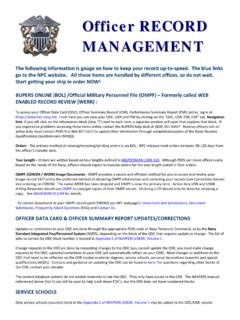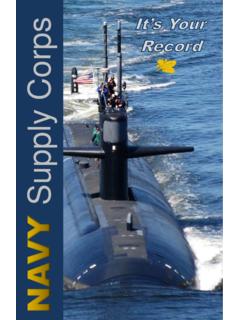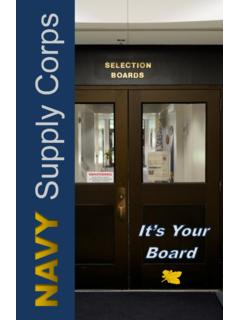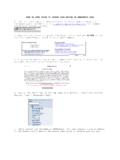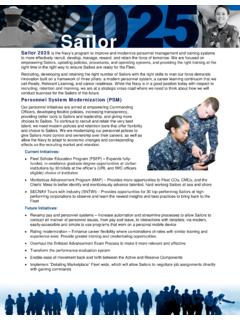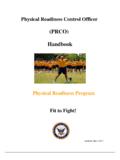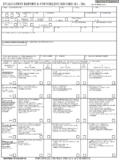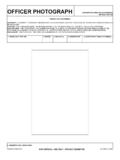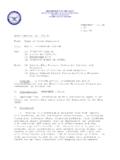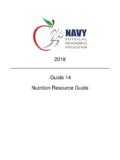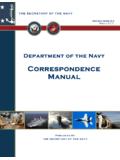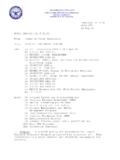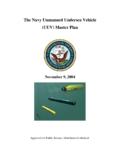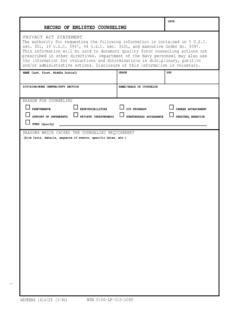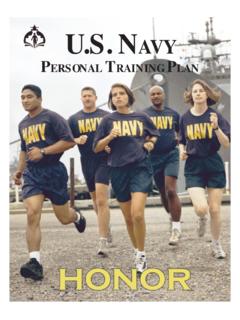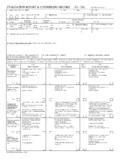Transcription of 2016 Guide 5 Physical Readiness Test (PRT) - U.S. …
1 JAN 2016. 2016. _____. Guide 5. Physical Readiness Test (PRT). 1. JAN 2016. Table of Contents Section I Physical Readiness Test (PRT) Guidelines Page 1. Purpose of the PRT .. 4. 2. Components of PRT 4. 3. Event Sequence .. 4. 4. PRT Scoring . 5. 5. Overall Physical Fitness Assessment (PFA) Score 5. Section 2 - Safety Concerns 1. Safety Concerns Prior to Conducting PRT . 6. 2. Conditioning and Test Safety 6. 3. Pre- Physical Activity Questions 7. 4. Warm-up .. 7. 5. Clothing 7. 6. Hydration . 8. 7. Cool-Down 8. 8. Injury Reporting .. 8. Section 3 PRT Event Procedures / Testing 1. Curl-ups 9. 2. Push-ups .. 10. 3. mile Run and/or Walk .. 11. 2. JAN 2016. 4. Treadmill Testing . 12. 5. 500 yard or 450-meter Swim . 13. 6. Alternative Cardio Options . 14. 7. Elliptical Testing .. 15. 8. Stationary Bike Testing 16. 9. Personnel at Increased Elevation.
2 16. 10. Grading the PRT .. 17. Section 4- Tables 1. PRT Standards for Altitudes Less Than 5000ft .. 18. Section 5- Tables 2. PRT Standards for Altitudes Greater Than 5000ft . 31. 3. JAN 2016. Section I Physical Readiness Test (PRT) Guidelines 1. Purpose of PRT. The PRT provides Commanding Officers (COs) with a means of assessing the general fitness of members of their command and provides a means to comply with DODI. to develop and administer a Physical fitness test that evaluates aerobic capacity, or cardio-respiratory endurance, and muscular strength, and muscular endurance. 2. Components of PRT. a. Cardio-respiratory fitness. Cardio-respiratory fitness, or aerobic capacity, is the ability of the heart and lungs to deliver oxygen to working muscles. It is associated with the ability to carry out strenuous work for long durations without undue fatigue.
3 The mile run/walk and 500-yard/450-meter swim tests are indicators of cardio-respiratory endurance. The alternate cardio options, elliptical, stationary bike and treadmill tests are also indicators, but participation in these events are at the CO's discretion. b. Muscular strength and endurance. Muscular strength and endurance is the ability to sustain muscle contractions over a period of time without undue fatigue. Curl- up and push-up events are indicators of muscular endurance. Although there is no single endurance test that measures the endurance of all muscles; the curl-up serves as a measure of abdominal muscle endurance while the push-up measures upper body muscular endurance. In addition, the curl-up, when performed properly, can help develop abdominal strength and endurance which are important factors in preventing low-back injuries.
4 3. Event Sequence PRT events shall be completed on the same day, at least 2 minutes, but no more than 15 minutes between each event and in the following sequence: a. Curl-ups b. Push-ups c. Cardio-respiratory fitness (run, swim, treadmill, elliptical or stationary bike). Due to the limited number of elliptical trainers and stationary bikes available, extra coordination may be required to ensure members do not exceed 15 minutes between the push-up and cardio-respiratory event. 4. JAN 2016. 4. PRT Scoring The PRT is broken down to 5 scoring categories, within the outstanding, excellent and good categories there are high, medium and low levels. Satisfactory has high and medium. Probationary is the lowest category and has no additional level. The following explains the categories: a. OUTSTANDING. Performance above or equal to top 10 percentile.
5 B. EXCELLENT. Performance in top 25 percentile, but less than OUTSTANDING. c. GOOD. Performance better than or equal to lowest 25 percentile, but less than EXCELLENT. d. SATISFACTORY/PROBATIONARY. Performance in bottom 25 percentile, but above lowest 10th percentile. e. FAILURE Performance in lowest 10 percentile. f. PARTIAL PASS. Scoring used by PRIMS to indicate that the member passed the PRT but was waived from one or more PRT event. g. Body Composition Assessment (BCA) PASS. Scoring used by PRIMS to indicate that the member passed the BCA but was authorized a non-participation status for the PRT. 5. Overall Physical Fitness Assessment (PFA) Score Overall score is category-level performance corresponding to the average of points accumulated on PRT events. Members must pass all three PRT events to receive an overall score.
6 Members must perform push-ups, curl-ups, and a cardio-respiratory event. 5. JAN 2016. Section 2 - Safety Concerns 1. Safety Concerns Prior to Conducting PRT. Complete Operational Risk Management (ORM) analysis at least 24 hours prior to the PRT. Ensure a change analysis is conducted anytime there is a significant change in any portion of the PRT. Guidelines on conducting a successful ORM analysis may be found in OPNAVINST and the COMNAVSAFECEN web-site: . Eliminate all known risks to the maximum extent possible. Controls shall be put in place to reduce, to an acceptable level, any remaining risks. It is recommended the ORM. process be documented and the appropriate level of authority within the chain of command be given the opportunity to make risk decisions. 2. Conditioning and Test Safety There is a natural risk of injury for all personnel participating in Physical activity, even those related to improving health.
7 The environment and the characteristics of the participants also contribute to the overall injury risk. Members must be informed of these risks and taught how to minimize the possibility of injury. To reduce the potential for injury, commands are responsible to ensure member's level of Physical fitness, including acclimatization to environment, is appropriate for the Physical demands required of PT, PRT, and other Physical activities. a. Support Personnel. The Command Fitness Leader (CFL) will ensure at least one Cardio Pulmonary Resuscitation (CPR)-certified monitor, in addition to CFL/Assistant CFL (ACFL) conducting the test, is present for every 25 members participating in a PRT, with a minimum of two monitors for every test. Monitors cannot be test participants and do not have to be members of the medical staff.
8 B. Medical Emergency Assistance. A safety plan must be in place for summoning emergency assistance. At a minimum, the plan must include telephone numbers and procedures for summoning aid, clear directions for emergency response personnel to avoid confusion and ensure prompt arrival. Include guidance for contacting base security personnel to assist with rapid access of emergency personnel to test site. c. Emergency Drill. The safety plan will include an emergency drill which will be conducted prior to the PFA by the CFL with ACFLs, support personnel, and PRT. monitors. The emergency drill will assess skills and review emergency procedures. The drill will include various scenarios and will be practiced until the desired results are obtained. 6. JAN 2016. d. Test Site Selection and/or Certification. The CFL will select the most level mile course available.
9 The course will be free of steep inclines and declines, surface irregularities, and sharp turns. Verify or measure course distance with measuring wheel (usually available from recreation services). A bike odometer may only be used if measuring wheel is not available. Do not use automobile or motorcycle odometers or GPS devices. e. Cardiopulmonary resuscitation (CPR)-certified personnel. The CFL will ensure CPR certified personnel are in place at appropriate intervals so the entire course is in view of monitors. The test site must be accessible to emergency vehicles and provide for telephone access for notification of emergency services if needed. Cellular phones, walkie-talkies, and other two-way communication devices are acceptable. When swim is conducted for the PRT, at least one certified lifeguard must be present.
10 F. Weather Safety Concerns. The PRT is not to be conducted under harsh environmental conditions. Specifically, the PRT should not be conducted outdoors when wind chill is 20 degrees Fahrenheit or lower, or when hot weather black flag conditions exist (wet bulb globe temperature [WBGT]) of 90 degrees Fahrenheit or higher. 3. Pre- Physical Activity Questions Prior to the PRT, FEP or command PT members must be asked pre- Physical activity questions. Members recovering from a recent illness or reporting a change in health or risk factors (specifically, a tightness or discomfort in the chest, arms, or neck associated with activity or exercise) are not to be tested. Members reporting a change in risk factors will be referred to medical for an evaluation and medical clearance. CFLs are to be able to recognize symptoms of cardiac distress (chest pain, shortness of breath, arm and neck pain) with participants.
